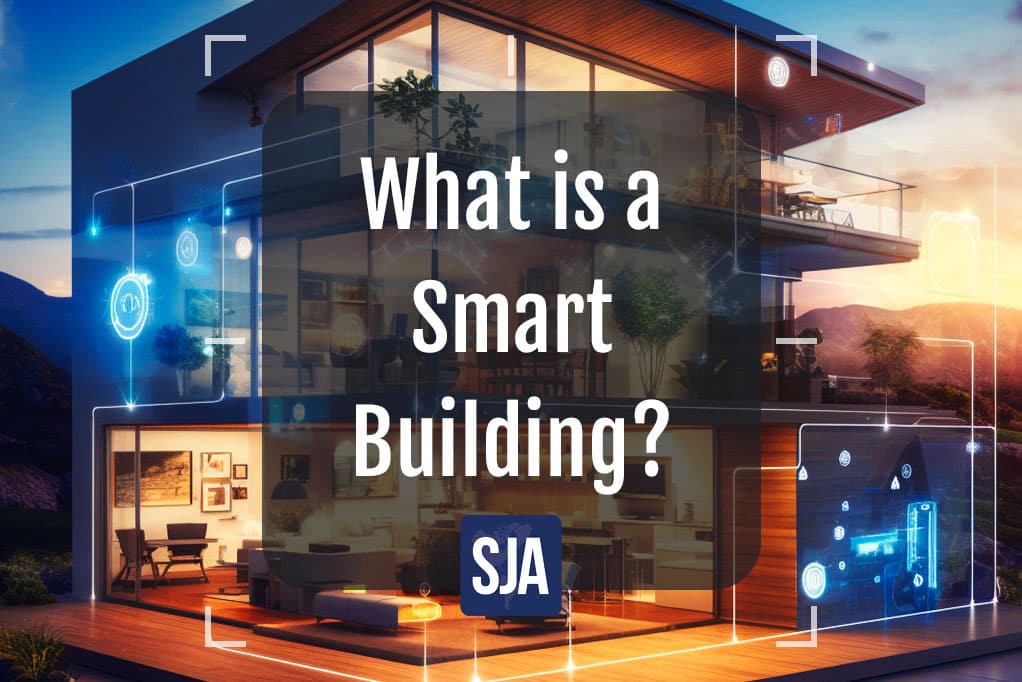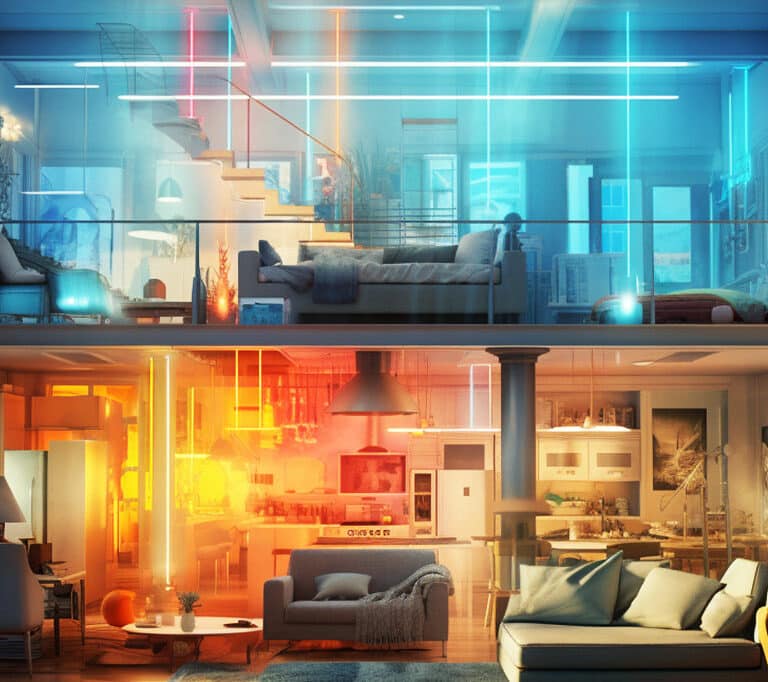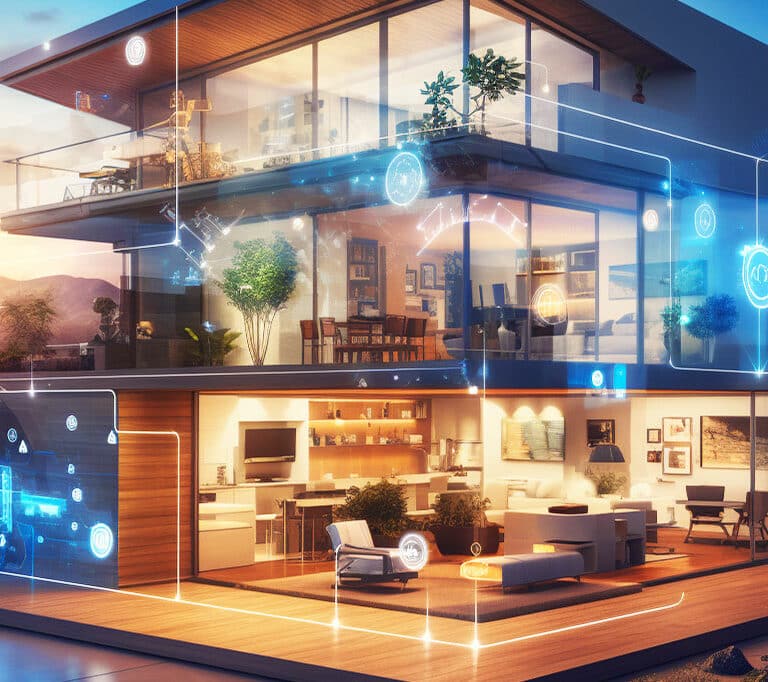What is a Smart Building? Exploring the Amazing Future of Intelligent Infrastructure


Simon Burge
Share this content
The relentless progress of technology in recent times has given birth to an exciting concept known as a ‘smart building’.
This brings up the question however, of exactly what is a smart building?
Combining cutting-edge technology with infrastructure, smart buildings are revolutionising the way we interact with the built environment.
From optimising energy consumption to improving security and automation, these intelligent structures are reshaping the future of architecture and construction.
In this article, we will delve into the intricacies of smart buildings, exploring what they are, how they work, and the benefits and downsides they offer.
We will also touch upon the costs associated with implementing smart building technologies and highlight the key players driving innovation in this transformative industry.
Whether you’re a curious individual interested in the latest advancements in building technologies or a professional seeking to understand the potential impact of smart buildings on the industry, this article will provide you with a comprehensive overview of this exciting and rapidly evolving field.
Join us as we unravel the mysteries behind smart buildings and explore the immense potential they hold in creating sustainable, efficient, and intelligent spaces.
Article Chapters
ToggleWhat is a Smart Building?
A smart building, or intelligent building, refers to buildings that use integrated systems and automation that monitors and improves various aspects of its operations, including energy usage, security, maintenance, and overall functionality.
It uses sensors, data analytics, and connectivity to enable efficient and intelligent management.
A smart building uses advanced technologies like the Internet of Things (IoT), artificial intelligence (AI), and cloud computing to create an interconnected ecosystem that maximises resource spread and enhances user experience.
How does a Smart Building Work?
Smart buildings are the future of architecture and infrastructure, using advanced technology and intelligent design to optimise day-to-day operations, improve energy efficiency, and enhance comfort of the user.
To understand how a smart building works, we need to explore the connected systems, sensors, and automation that make it all possible.

At the heart of a smart building lies a network of sensors strategically placed throughout the facility. These sensors serve as the eyes and ears of the building, collecting real-time data on various environmental parameters such as temperature, lighting levels, occupancy, air quality, and even humidity.
The collected data is then transmitted to a centralised control system, often referred to as the building management system (BMS) or the Internet of Things (IoT) platform.
The control system is the brain of the smart building, where all the data is processed and analysed.
Using sophisticated algorithms and machine learning capabilities, the control system can make informed decisions and trigger appropriate actions based on the collected data.
For example, if occupancy sensors detect an empty room, the control system can automatically adjust the lighting and temperature settings to conserve energy.
Similarly, if the air quality sensors detect a decrease in air quality, the control system can activate the ventilation system to improve indoor air quality.
Connectivity plays a crucial role in the functioning of a smart building.
Through the use of wired and wireless networks, the sensors and the control system communicate and exchange information seamlessly.
This connectivity allows for real-time monitoring and control of various building systems, creating a responsive and intelligent environment.
It also enables the control system to have a holistic view of the building’s operations, facilitating data-driven decision-making and optimization.
One of the key features of a smart building is its ability to adapt and learn from its environment.
Machine learning algorithms enable the control system to analyse historical data and patterns, allowing it to optimise operations and predict future outcomes.
For example, the control system can learn occupancy patterns and adjust lighting and HVAC settings accordingly, ensuring optimal comfort while minimising energy consumption.
Smart buildings also offer occupants a higher level of personalization and customization.
Through user interfaces such as mobile apps or control panels, occupants can have control over their environment.
They can adjust lighting, temperature, and even access certain features or services with ease.
This level of customization not only enhances occupant comfort but also promotes a sense of empowerment and engagement with the building.
What are the Benefits of a Smart Building?
Energy Efficiency
By using the power of real-time data, smart buildings have the ability to optimise energy consumption, leading to significant reductions in energy waste and carbon footprint.
Automated lighting control systems ensure that lights are only activated when needed, while dimming or turning off lights in unoccupied areas.
A smart building allows for precise control of heating, ventilation, and air conditioning systems, ensuring that energy is used efficiently to maintain comfortable temperatures.
Smart buildings also employ intelligent power management systems that regulate the usage of electrical devices and equipment, minimising unnecessary power consumption during periods of low demand or non-usage.
These energy-saving measures not only reduce environmental impact but also result in substantial cost savings for building owners and occupants.
Additionally, the integration of renewable energy sources such as solar panels or wind turbines further enhances the sustainability of smart buildings, allowing them to generate clean and renewable energy to power their operations.
With their focus on energy optimization and sustainability, smart buildings are at the forefront of promoting a greener and more environmentally conscious approach to building design and operation.
Enhanced Comfort and Productivity
The well-being of occupants is a top priority for smart buildings, and they achieve this by creating personalised environments that cater to individual needs and preferences.

Automated climate control systems ensure that temperature and humidity levels are maintained within the desired range, creating a comfortable atmosphere for occupants throughout the day.
Adaptive lighting systems adjust the brightness and colour temperature of lighting fixtures based on natural light levels and occupant preferences, promoting productivity and reducing eye strain.
Improved ventilation systems monitor air quality and adjust airflow rates to ensure a constant supply of fresh and clean air, contributing to a healthier indoor environment.
A smart building also offers occupants the ability to personalise their workspace through user interfaces such as mobile apps or control panels.
Occupants can adjust settings according to their preferences, such as temperature, lighting, or even access to certain services within the building.
By prioritising occupant well-being and providing personalised environments, smart buildings create a conducive and productive workspace that enhances comfort, satisfaction, and overall occupant experience.
Improved Safety and Security
Safety and security are paramount in smart buildings, which incorporate integrated security and intelligent key management systems to protect occupants and assets.
Surveillance cameras strategically placed throughout the building monitor activity and enable real-time monitoring of different areas.
Access control systems regulate entry to secure areas, ensuring that only authorised individuals can access sensitive locations.
‘Smart glass’ can be used to improve both privacy and security, with users able to switch from clear to frosted glass in an instant.
Fire detection systems employ sensors that can detect the presence of smoke or fire, triggering alarms and initiating emergency response procedures.
The power of smart buildings lies in their ability to quickly identify potential threats and respond proactively.
By leveraging data from sensors, the centralised control system can analyse and detect anomalies that may indicate security risks. In the event of a security breach or emergency.
The control system can then trigger alarms, alert security personnel, and facilitate appropriate emergency response protocols.
This rapid response can help mitigate risks, minimise damage, and ensure the safety of occupants and assets within the building.
The integration of these security systems within the smart building framework creates a comprehensive and cohesive approach to safety and security management.
By leveraging advanced technology, smart buildings enhance the overall safety of occupants, protecting them from potential threats and providing peace of mind in an ever-evolving security landscape.
Streamlined Maintenance and Operations
Real-time monitoring and predictive analytics are key features of smart buildings that enable proactive maintenance practices.
By continuously monitoring the performance of various building systems and equipment, smart buildings can detect potential malfunctions or failures in advance.
This early detection allows for scheduled repairs or maintenance activities to prevent costly breakdowns or disruptions.
Furthermore, the use of predictive analytics helps identify patterns and trends in data, allowing for improved resource allocation.
Smart buildings can allocate maintenance resources based on actual usage and wear, reducing unnecessary maintenance and optimising operational efficiency.
As a result, smart buildings experience reduced downtime, increased equipment lifespan, and significant cost savings in maintenance and repair expenses.
The ability to proactively address maintenance needs ensures that the building operates smoothly and minimises disruptions, creating a more efficient and reliable environment for occupants.
Sustainability
Smart buildings go beyond improving energy efficiency and resource management; they actively contribute to a sustainable future.
By implementing energy-efficient systems and technologies, smart buildings reduce their environmental impact and align with green building certifications such as LEED (Leadership in Energy and Environmental Design) and BREEAM (Building Research Establishment Environmental Assessment Method).
These certifications recognise and promote sustainable building practices, highlighting the commitment of smart buildings to environmental stewardship and sustainable development.
What are the Downsides to a Smart Building?
High Implementation Costs
The initial investment required for transforming a conventional building into a smart building can be substantial.
Costs include the installation of sensors, infrastructure upgrades, integration of systems, and training personnel. However, it is important to note that the long-term benefits often outweigh the upfront expenses.
Cybersecurity Risks
As smart buildings and smart homes rely heavily on connected systems and data exchange, they are susceptible to cyber threats.

Adequate security measures must be in place to protect against unauthorised access and potential data breaches.
Technical Challenges
Integrating various building systems from different manufacturers can be complex.
Compatibility issues, operation challenges, and vendor lock-in can hinder the seamless operation of a smart building.
How much does a Smart Building cost?
The cost of implementing a smart building can vary depending on several factors, including the size of the building, the complexity of systems and the level of automation needed.
Generally, the cost can range from around $50 for a basic starting point, to upwards of six to seven figures for a full top of the range system.
While the initial investment may seem significant, the long-term energy savings, operational efficiency, and improved occupant satisfaction can provide a substantial return on investment.
Who Makes Smart Buildings?
The development and implementation of smart building solutions involve a collaboration of multiple stakeholders.
Architectural firms, engineering consultants, construction companies, and technology providers work together to design, construct, and retrofit buildings with smart systems.
Some prominent players in the smart building industry include Siemens, Honeywell, Johnson Controls, Schneider Electric, IBM, Cisco, and Google.

Conclusion
Smart buildings represent the future of intelligent infrastructure, reshaping the way we interact with our built environment and are bringing change to the future of work, school, and our home life..
By integrating advanced technologies, data-driven decision-making, and automation, these buildings offer numerous benefits such as energy efficiency, improved comfort, enhanced safety, streamlined operations, and sustainability.
While there are challenges to overcome, the rapid evolution of the smart building industry and the collective efforts of various stakeholders are paving the way for a more connected, efficient, and sustainable built environment.


